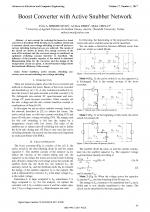| 1/2017 - 8 |
Boost Converter with Active Snubber NetworkHIMMELSTOSS, F. A. |
| Extra paper information in |
| Click to see author's profile in |
| Download PDF |
Author keywords
snubbers, active circuits, switching converters, zero current switching, zero voltage switching
References keywords
power(14), electronics(12), converters(10), boost(8), converter(7), elec(6), zero(5), transition(5), switching(5), novel(5)
Blue keywords are present in both the references section and the paper title.
About this article
Date of Publication: 2017-02-28
Volume 17, Issue 1, Year 2017, On page(s): 55 - 60
ISSN: 1582-7445, e-ISSN: 1844-7600
Digital Object Identifier: 10.4316/AECE.2017.01008
Web of Science Accession Number: 000396335900008
SCOPUS ID: 85014228793
Abstract
A new concept for reducing the losses in a boost converter is described. With the help of an auxiliary switch and a resonant circuit, zero-voltage switching at turn-off and zero-current switching during turn-on are achieved. The modes of the circuit are shown in detail. The energy recovery of the turn-off is analyzed and the recovered energy is calculated; an optimized switching concept therefore is described. The influence of the parasitic capacity of the switch is discussed. Dimensioning hints for the converter and the design of the recuperation circuit are given. A bread-boarded design shows the functional efficiency of the concept. |
| References | | | Cited By |
Web of Science® Times Cited: 4 [View]
View record in Web of Science® [View]
View Related Records® [View]
Updated 3 weeks, 6 days ago
SCOPUS® Times Cited: 5
View record in SCOPUS® [Free preview]
View citations in SCOPUS® [Free preview]
[1] Single-Phase Direct Boost AC-AC Converter, URSARU, O., LUCANU, M., AGHION, C., LUCANU, N., Advances in Electrical and Computer Engineering, ISSN 1582-7445, Issue 4, Volume 17, 2017.
Digital Object Identifier: 10.4316/AECE.2017.04006 [CrossRef] [Full text]
[2] Design of dual loop controller for boost converter based on PI controller, Ullah, Kifayat, Ishaq, Muhammad, Naz, Muhammad Ajmal, Rahaman, Mostafizur, Soomar, Arsalan Muhammad, Ahmad, Hijaz, Alam, Md. Nur, AIP Advances, ISSN 2158-3226, Issue 2, Volume 14, 2024.
Digital Object Identifier: 10.1063/5.0191079 [CrossRef]
[3] Quadratic DC/DC converter with autotransformer at the output side, Himmelstoss, Felix A., Votzi, Helmut L., Windisch, Michael, 2020 IEEE 29th International Symposium on Industrial Electronics (ISIE), ISBN 978-1-7281-5635-4, 2020.
Digital Object Identifier: 10.1109/ISIE45063.2020.9152470 [CrossRef]
[4] Tapped inductor Boost with exploitation of the stray energy, Himmelstoss, Felix, Windisch, Michael, 2022 IEEE 20th International Power Electronics and Motion Control Conference (PEMC), ISBN 978-1-6654-9681-0, 2022.
Digital Object Identifier: 10.1109/PEMC51159.2022.9962849 [CrossRef]
Disclaimer: All information displayed above was retrieved by using remote connections to respective databases. For the best user experience, we update all data by using background processes, and use caches in order to reduce the load on the servers we retrieve the information from. As we have no control on the availability of the database servers and sometimes the Internet connectivity may be affected, we do not guarantee the information is correct or complete. For the most accurate data, please always consult the database sites directly. Some external links require authentication or an institutional subscription.
Web of Science® is a registered trademark of Clarivate Analytics, Scopus® is a registered trademark of Elsevier B.V., other product names, company names, brand names, trademarks and logos are the property of their respective owners.
Faculty of Electrical Engineering and Computer Science
Stefan cel Mare University of Suceava, Romania
All rights reserved: Advances in Electrical and Computer Engineering is a registered trademark of the Stefan cel Mare University of Suceava. No part of this publication may be reproduced, stored in a retrieval system, photocopied, recorded or archived, without the written permission from the Editor. When authors submit their papers for publication, they agree that the copyright for their article be transferred to the Faculty of Electrical Engineering and Computer Science, Stefan cel Mare University of Suceava, Romania, if and only if the articles are accepted for publication. The copyright covers the exclusive rights to reproduce and distribute the article, including reprints and translations.
Permission for other use: The copyright owner's consent does not extend to copying for general distribution, for promotion, for creating new works, or for resale. Specific written permission must be obtained from the Editor for such copying. Direct linking to files hosted on this website is strictly prohibited.
Disclaimer: Whilst every effort is made by the publishers and editorial board to see that no inaccurate or misleading data, opinions or statements appear in this journal, they wish to make it clear that all information and opinions formulated in the articles, as well as linguistic accuracy, are the sole responsibility of the author.



